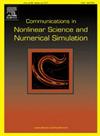非线性分数型乳腺癌风险系统的新型智能外生神经结构驱动机器学习方法
IF 3.4
2区 数学
Q1 MATHEMATICS, APPLIED
Communications in Nonlinear Science and Numerical Simulation
Pub Date : 2025-05-10
DOI:10.1016/j.cnsns.2025.108955
引用次数: 0
摘要
乳腺癌仍然是世界上最普遍和危及生命的疾病之一,需要数学建模框架来捕捉其进展和风险因素的复杂性。本研究在分数阶乳腺癌风险(FO-BCR)模型上使用自适应非线性自回归外源性(ANARX)神经网络揭示了新的机器学习探索。一个新的Caputo分数算子为基础的乳腺癌风险模型提出了使用五室系统反映健康,肿瘤,免疫,雌激素和脂肪细胞。选择一种改进的分数阶Adams PECE方法来生成四种不同BCR场景下五个分数阶变量的解。这些时间序列被解析为熟练的ANARX网络的基本真理,并使用Levenberg-Marquardt (LM)算法迭代改进。使用均方误差(MSE)性能图、输入误差互相关、误差自相关、误差直方图分析、顺序响应和比较误差分析图,对参考数值结果对ANARX-LM算法的时间特征学习的性能进行综合评估。在所有FO-BCR系统中观察到参考溶液之间的低差异,MSE误差范围为10−8至10−11。最后,使用单步和多步配置评估ANARX-LM的预测能力。在10 - 9至10 - 11、10 - 8至10 - 10范围内的微小误差表明对FO-BCR系统的准确预测能够为乳腺癌模型提供预防和预后措施。这些实证研究结果强调了先进的机器学习驱动的神经架构在下一代肿瘤预测解决方案中的潜力,这可能有助于促进治疗策略。本文章由计算机程序翻译,如有差异,请以英文原文为准。
Novel intelligent exogenous neuro-architecture–driven machine learning approach for nonlinear fractional breast cancer risk system
Breast cancer remains one of the most prevalent and life-threatening diseases worldwide, necessitating mathematical modelling frameworks to capture the complexity of its progression and risk factors. This research endeavor uncovers the novel machine learning expedition using an Adaptive Nonlinear AutoRegressive eXogenous (ANARX) neural network on a Fractional Order Breast Cancer Risk (FO-BCR) model. A novel Caputo fractional operator-based breast cancer risk model is presented using a five compartmental system reflected by healthy, tumor, immune, estrogen, and fatty cells. A modified fractional Adams PECE method is opted to generate solutions of the five fractional order variants on the four diverse BCR scenarios. These temporal sequences are parsed as ground truth for the adept ANARX network, which is iteratively refined using the Levenberg-Marquardt (LM) algorithm. The performance evaluation of the temporal feature learning of the ANARX-LM algorithm is comprehensively evaluated against reference numerical outcomes using mean square error (MSE) performance graphics, input-error cross correlation, error autocorrelation, error histogram analysis, sequential response and comparative error analysis charts. Low disparity between reference solutions is observed for all FO-BCR systems, with MSE errors in the range of 10−8 to 10−11. Finally, the ANARX-LM’s predictive prowess is evaluated using the single and multistep configurations. Minute errors in the range of 10−9 to 10−11, 10−8 to 10−10 suggest accurate anticipation of the FO-BCR system enabling preventive and prognostic measures for breast cancer models. These empirical findings underscore the potential of advanced machine-learning-driven neuro-architecture for next-generation predictive-oncology solutions that may facilitate treatment strategies.
求助全文
通过发布文献求助,成功后即可免费获取论文全文。
去求助
来源期刊

Communications in Nonlinear Science and Numerical Simulation
MATHEMATICS, APPLIED-MATHEMATICS, INTERDISCIPLINARY APPLICATIONS
CiteScore
6.80
自引率
7.70%
发文量
378
审稿时长
78 days
期刊介绍:
The journal publishes original research findings on experimental observation, mathematical modeling, theoretical analysis and numerical simulation, for more accurate description, better prediction or novel application, of nonlinear phenomena in science and engineering. It offers a venue for researchers to make rapid exchange of ideas and techniques in nonlinear science and complexity.
The submission of manuscripts with cross-disciplinary approaches in nonlinear science and complexity is particularly encouraged.
Topics of interest:
Nonlinear differential or delay equations, Lie group analysis and asymptotic methods, Discontinuous systems, Fractals, Fractional calculus and dynamics, Nonlinear effects in quantum mechanics, Nonlinear stochastic processes, Experimental nonlinear science, Time-series and signal analysis, Computational methods and simulations in nonlinear science and engineering, Control of dynamical systems, Synchronization, Lyapunov analysis, High-dimensional chaos and turbulence, Chaos in Hamiltonian systems, Integrable systems and solitons, Collective behavior in many-body systems, Biological physics and networks, Nonlinear mechanical systems, Complex systems and complexity.
No length limitation for contributions is set, but only concisely written manuscripts are published. Brief papers are published on the basis of Rapid Communications. Discussions of previously published papers are welcome.
 求助内容:
求助内容: 应助结果提醒方式:
应助结果提醒方式:


